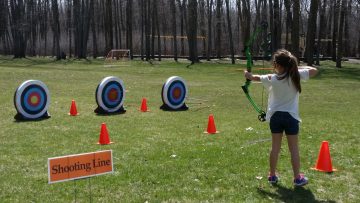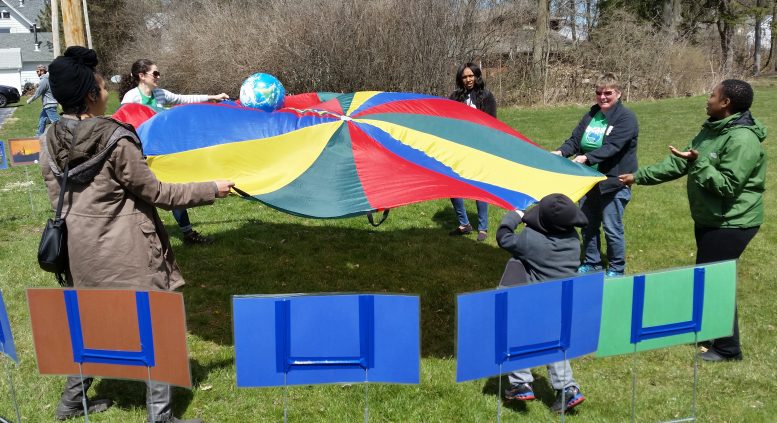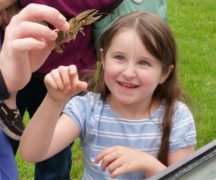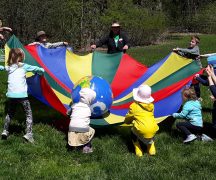By JAN LARSON McLAUGHLIN
BG Independent News
After weeks of cruel winter-like weather, Mother Nature graced the region with springtime just in time for Earth Day.
The sunshine was a perfect backdrop Sunday afternoon for kids learning about nature, recycling and energy at the ninth annual community Earth Day celebration. The fun lessons included serious messages, such as:
- An estimated 20 pounds of food per person, per month is thrown away in the U.S.
- Trees in public spaces in Bowling Green intercept more than 7.4 million gallons of stormwater each year.
- The Wood County District Public Library bookmobile runs on compressed natural gas, which is an abundant, low-cost, green alternative to gasoline or diesel.
- Turning off the water faucet when brushing teeth could save 5,480 gallons of water a year.

The yard outside the Montessori School in Bowling Green was covered with kids learning about helping Monarch butterflies, protecting Lake Erie, planting trees and saving the Earth.
Many of the children signed pledges that gave them specific ideas of how to help the Earth. To be a “Clean Water Superhero,” kids agreed to shorten their showers, pick up litter, adopt a storm drain and turn off the water when brushing teeth. Some agreed to “pick up pet poo,” to prevent bacteria from getting in water sources.
The lesson, according to Bowling Green Sustainability Coordinator Amanda Gamby, is that kids can make a difference.
“We can do things individually at home to help,” Gamby said.
Kids learned about the importance of dragonflies, flower pollination, and nature’s food chains.
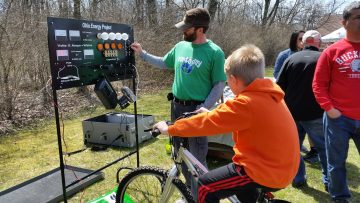
They also learned how much energy is takes to operate small household appliances. With the help of Jason Sisco, engineer with the city of Bowling Green, kids pedaled a bicycle to get an idea of how hard they had to work to create enough power to run light bulbs, then a radio, a hairdryer and a fan.
Children got to plant saplings and sunflower seeds to take home.
They learned about the need for humans to protect Monarch butterflies.
“I’m trying to get everybody excited about Monarch butterflies, and how to help them,” said Cinda Stutzman, natural resources specialist with the Bowling Green Parks and Recreation Department.
“Monarch populations have been plummeting for several years,” so much so that they are now on the endangered species list, she said.
The reason is because the butterflies need milkweed plants for reproduction.
“We’ve done such a good job getting rid of milkweed,” Stutzman said. She is trying to get Bowling Green residents to plant butterfly weed, which will attract the Monarchs back.
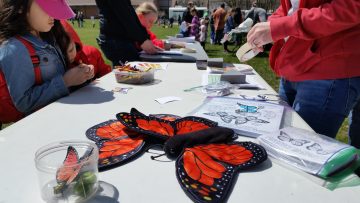
Several Bowling Green State University environmental education students had stations set up for interactive learning. One site had three ecosystems of Lake Erie, the Maumee River and the Great Black Swamp – and children were asked to put wildlife where it belonged.
“We want them to get a better idea of what’s around them, native plants and animals,” said BGSU student Carmen Highhouse.
Another station examined the effects of oil spills on water and waterfowl, and discussed how solar and wind power don’t raise such risks. Oil was put into water and onto feathers, and different efforts were made to clean up the water, using sponges or skimmers.
“We’re showing different ways to clean up oil,” BGSU student Piper Jones said. “We want to show that ultimately, it’s hard to get oil out of water.”
One station had a secret weapon to attract young learners. The lesson involved chocolate pudding, cookie crumbs, and gummy worms.
“Worms are good,” BGSU student Grace Patterson said. They help with decomposition of the soil.
“We would always dig them up,” as kids, Patterson said. “We need to let them be, so they can do their jobs.”
